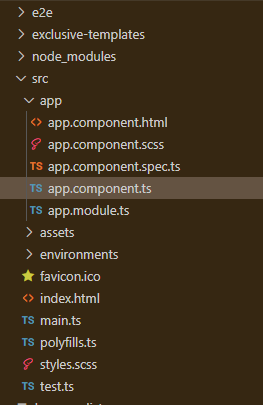Angular MDBootstrap Forms Checkbox Component
Last Updated :
06 Jan, 2023
MDBootstrap is a Material Design and bootstrap-based Angular UI library that is used to make attractive webpages with its seamless and easy-to-use component. In this article, we will know how to use Checkbox Component in Angular MDBootstrap.
A Checkbox Component lets a user definitely choose a value from a limited number of choices in a subtle way.
Syntax:
<mdb-checkbox >CheckBox 1</mdb-checkbox>
Approach:
- Download Angular MDBootstrap from the official site.
- Extract the files and change them to the working directory.
- Install npm in the current project using the following command:
npm install
- After creating your project folder i.e. appname, move to it using the following command:
cd appname
- Start the server using the following command:
ng serve
Project Structure: After complete installation, it will look like the following:

Project Structure
Example 1: This is the basic example that illustrates how to use the Checkbox Component in Angular MDBootstrap.
app.component.html
<div id='gfg'>
<h1>GeeksforGeeks</h1>
<h4>Angular MDBootstrap Checkbox Component</h4>
<br />
<mdb-checkbox [default]="true">
CheckBox 1
</mdb-checkbox>
<mdb-checkbox [default]="true">
CheckBox 2
</mdb-checkbox>
<mdb-checkbox [default]="true">
CheckBox 3
</mdb-checkbox>
</div>
|
app.component.ts
import { Component } from '@angular/core';
@Component({
selector: 'app-root',
templateUrl: './app.component.html',
styleUrls: ['./app.component.css']
})
export class AppComponent {}
|
app.module.ts
import { BrowserModule } from "@angular/platform-browser";
import { NgModule } from "@angular/core";
import { BrowserAnimationsModule }
from "@angular/platform-browser/animations";
import { AppComponent } from "./app.component";
import { MDBBootstrapModule } from "angular-bootstrap-md";
import { FormsModule } from "@angular/forms";
@NgModule({
declarations: [AppComponent],
imports: [
BrowserModule,
BrowserAnimationsModule,
MDBBootstrapModule.forRoot(),
FormsModule,
],
providers: [],
bootstrap: [AppComponent],
})
export class AppModule {}
|
Output:
Example 2: In this example, we will know how to use the checked state property in Checkbox Component.
app.component.html
<div id='gfg'>
<h1>GeeksforGeeks</h1>
<h4>Angular MDBootstrap Checkbox Component</h4>
<br />
<mdb-checkbox [checked]="true">
CheckBox 1
</mdb-checkbox>
<mdb-checkbox [checked]="true">
CheckBox 2
</mdb-checkbox>
<mdb-checkbox [checked]="true">
CheckBox 3
</mdb-checkbox>
</div>
|
app.component.ts
import { Component } from '@angular/core';
@Component({
selector: 'app-root',
templateUrl: './app.component.html',
styleUrls: ['./app.component.css']
})
export class AppComponent {}
|
app.module.ts
import { BrowserModule } from "@angular/platform-browser";
import { NgModule } from "@angular/core";
import { BrowserAnimationsModule }
from "@angular/platform-browser/animations";
import { AppComponent } from "./app.component";
import { MDBBootstrapModule } from "angular-bootstrap-md";
import { FormsModule } from "@angular/forms";
@NgModule({
declarations: [AppComponent],
imports: [
BrowserModule,
BrowserAnimationsModule,
MDBBootstrapModule.forRoot(),
FormsModule,
],
providers: [],
bootstrap: [AppComponent],
})
export class AppModule {}
|
Output:
Example 3: In this example, we will know how to use indeterminate state property in Checkbox Component.
app.component.html
<div id='gfg'>
<h1>GeeksforGeeks</h1>
<h4>Angular MDBootstrap Checkbox Component</h4>
<br />
<mdb-checkbox [indeterminate]="true"
[default]="true">
CheckBox 1
</mdb-checkbox>
<mdb-checkbox [indeterminate]="true"
[default]="true">
CheckBox 2
</mdb-checkbox>
<mdb-checkbox [indeterminate]="true"
[default]="true">
CheckBox 3
</mdb-checkbox>
</div>
|
app.component.ts
import { Component } from '@angular/core';
@Component({
selector: 'app-root',
templateUrl: './app.component.html',
styleUrls: ['./app.component.css']
})
export class AppComponent {}
|
app.module.ts
import { BrowserModule } from "@angular/platform-browser";
import { NgModule } from "@angular/core";
import { BrowserAnimationsModule }
from "@angular/platform-browser/animations";
import { AppComponent } from "./app.component";
import { MDBBootstrapModule } from "angular-bootstrap-md";
import { FormsModule } from "@angular/forms";
@NgModule({
declarations: [AppComponent],
imports: [
BrowserModule,
BrowserAnimationsModule,
MDBBootstrapModule.forRoot(),
FormsModule,
],
providers: [],
bootstrap: [AppComponent],
})
export class AppModule {}
|
Output:
Example 4: In this example, we will know how to use the disabled state property in Checkbox Component.
app.component.html
<div id='gfg'>
<h1>GeeksforGeeks</h1>
<h4>Angular MDBootstrap Checkbox Component</h4>
<br />
<mdb-checkbox [disabled]="true"
[indeterminate]="true"
[default]="true">
CheckBox 1
</mdb-checkbox>
<mdb-checkbox [disabled]="true"
[default]="true">
CheckBox 2
</mdb-checkbox>
<mdb-checkbox [disabled]="true"
[checked]="true"
[default]="true">
CheckBox 3
</mdb-checkbox>
</div>
|
app.component.ts
import { Component } from '@angular/core';
@Component({
selector: 'app-root',
templateUrl: './app.component.html',
styleUrls: ['./app.component.css']
})
export class AppComponent {}
|
app.module.ts
import { BrowserModule } from "@angular/platform-browser";
import { NgModule } from "@angular/core";
import { BrowserAnimationsModule }
from "@angular/platform-browser/animations";
import { AppComponent } from "./app.component";
import { MDBBootstrapModule } from "angular-bootstrap-md";
import { FormsModule } from "@angular/forms";
@NgModule({
declarations: [AppComponent],
imports: [
BrowserModule,
BrowserAnimationsModule,
MDBBootstrapModule.forRoot(),
FormsModule,
],
providers: [],
bootstrap: [AppComponent],
})
export class AppModule {}
|
Output:
Example 5: In this example, we will know how to use the inline property in Checkbox Component.
app.component.html
<div id='gfg'>
<h1>GeeksforGeeks</h1>
<h4>Angular MDBootstrap Checkbox Component</h4>
<br />
<mdb-checkbox [inline]="true"
[indeterminate]="true"
[default]="true">
CheckBox 1
</mdb-checkbox>
<mdb-checkbox [inline]="true"
[default]="true">
CheckBox 2
</mdb-checkbox>
<mdb-checkbox [inline]="true"
[checked]="true"
[default]="true">
CheckBox 3
</mdb-checkbox>
</div>
|
app.component.ts
import { Component } from '@angular/core';
@Component({
selector: 'app-root',
templateUrl: './app.component.html',
styleUrls: ['./app.component.css']
})
export class AppComponent {}
|
app.module.ts
import { BrowserModule } from "@angular/platform-browser";
import { NgModule } from "@angular/core";
import { BrowserAnimationsModule }
from "@angular/platform-browser/animations";
import { AppComponent } from "./app.component";
import { MDBBootstrapModule } from "angular-bootstrap-md";
import { FormsModule } from "@angular/forms";
@NgModule({
declarations: [AppComponent],
imports: [
BrowserModule,
BrowserAnimationsModule,
MDBBootstrapModule.forRoot(),
FormsModule,
],
providers: [],
bootstrap: [AppComponent],
})
export class AppModule {}
|
Output:
Reference: https://mdbootstrap.com/docs/angular/forms/checkbox/
Share your thoughts in the comments
Please Login to comment...